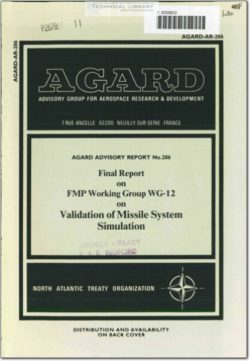AGARD-AR-206
- Version
- 213 Downloads
- 27.71 MB File Size
- 1 File Count
- April 25, 2016 Create Date
- April 25, 2016 Last Updated
Final Report on FMP Working Group WG-12 on Validation of Missile System Simulation

The AGARD Flight Mechanics Panel (FM?) has been concerned with the
problem of missile simulation in general, and cooperative NATO
developments of missile system simulations, test, and evaluation as
related to missile system flight mechanics in particular. As a result,
the FMP sponsored a survey of missile simulation facilities reported in
AGARDograph No. 279, "Survey of Missile Simulation and Flight Mechanics
in NATO," by Willard M. Holmes, April 1983. One of the key findings in
this survey was that very little effort is being expended in missile
simulation validation. Furthermore, validation techniques themselves
are generallv not standard; often being ill—defined or undocumented.
This fact motivated the formation of FM? Working Group 12,
"Validation of Missile Svsten Simulation." This report documents the
group findings.
Although there is no shortage of reference material on missile
simulations per se, there seems to be no "history" on the subject, like
the manned simulation community, (e.g., The Pilot Maker, by Floyd L.
Kelly as told to Robert B. Parks, Grosset and Dunlap, 1970). The manned
simulation world, founded first in training simulators and later in
research and development simulators, is also just now realizing the need
for simulation validation.
Perhaps, in both cases, the evolution of simulation equipment from
extremely crude mechanical devices to modern electronic "arcade game
simulators” happened so fast that it is only recently that people began
to ask,."Do they really work“? Or, perhaps the early equipment
reliability problems were such that everyone was quite happy if the
simulation appeared to be "working", let alone providing "useful"
results.
In any event, times have changed, and in both manned aircraft
simulations and missile simulations the question of validation is
becoming of more and more serious concern.
But where does one start in terms of defining how to validate
missile simulations when few organizations do any formal validation now
and there are no agreed upon standards whatsoever? This was the
extremely broad and difficult question the working group had to
repeatedly ask itself.
| File | Action |
|---|---|
| AGARD-AR-206 Final Report on FMP Working Group WG-12 on Validation of Missile System Simulation.pdf | Download |

Comment On This Post